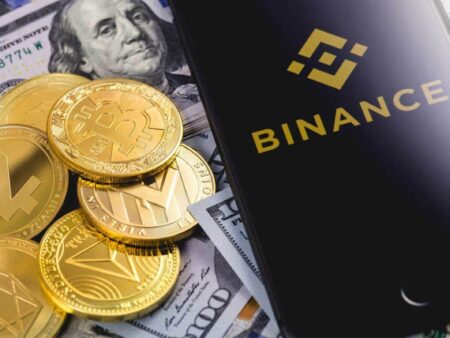In recent years, cryptocurrency has transitioned from a niche investment to a mainstream financial asset. As this digital currency trend continues to evolve, more investors are looking for easy and convenient ways to enter the market. One of the most accessible methods for purchasing cryptocurrency is through a credit card. This guide explores the steps involved in buying cryptocurrency using a credit card, ensuring a safe and secure transaction.
Understanding the Basics of Cryptocurrency Purchases
Before diving into the purchasing process, it’s essential to understand what cryptocurrency is. Cryptocurrency is a digital or virtual form of currency that uses cryptography for secure transactions and control the creation of additional units. Unlike traditional currencies, cryptocurrencies operate on decentralized networks based on blockchain technology.
When purchasing cryptocurrency, you are essentially exchanging your fiat currency (like USD or EUR) for digital assets. The process can seem daunting, especially for newcomers, but understanding a few basics can simplify it. First, familiarize yourself with popular cryptocurrencies like Bitcoin (BTC), Ethereum (ETH), and Litecoin (LTC). Each has its own unique features and market dynamics.
Cryptocurrency purchases can occur on various platforms, known as exchanges. These exchanges facilitate the buying, selling, and trading of cryptocurrencies. It’s crucial to choose a reliable exchange, particularly when using a credit card, as this payment method involves sharing sensitive financial information.
One of the advantages of buying cryptocurrency with a credit card is the speed of the transaction. Unlike bank transfers that may take several days to process, credit card transactions can be completed within minutes, allowing you to react promptly to market changes.
However, potential buyers must also be aware of the risks associated with such purchases. Credit card transactions may incur high fees, and there are security concerns regarding sharing your financial information with online platforms. Understanding these risks is essential before proceeding with a credit card purchase.
Finally, it’s important to consider your investment objectives and risk appetite. Cryptocurrencies can be volatile, and while they offer the potential for significant returns, they also carry substantial risks. Assess your financial situation and consider consulting with a financial advisor if necessary.
Choosing the Right Exchange for Credit Card Transactions
Selecting the right cryptocurrency exchange is a critical step when planning to buy cryptocurrency using a credit card. Several exchanges accept credit card payments, but they vary in terms of fees, security features, and user experience. Here are key factors to consider:
- Reputation and Trustworthiness: Research the exchange’s reputation in the crypto community. Look for reviews and ratings to gauge its reliability.
- Fees: Different exchanges charge varying fees for credit card transactions. Be sure to compare these fees, as they can significantly affect your investment.
- Supported Cryptocurrencies: Ensure the exchange offers the cryptocurrency you wish to purchase. Some platforms specialize in specific coins.
To help you compare some of the most popular exchanges that allow credit card purchases, here is a thematic table:
| Exchange Name | Fees (Approx.) | Supported Cryptocurrencies |
|---|---|---|
| Binance | 1.8% | BTC, ETH, LTC, and more |
| Coinbase | 3.99% | BTC, ETH, LTC, and more |
| Kraken | 3.75% | BTC, ETH, LTC, and more |
In addition to these factors, consider the user interface of the exchange. A user-friendly platform can make your purchasing experience smoother, particularly if you’re new to cryptocurrency. Look for exchanges that offer mobile apps, educational resources, and responsive customer support.
Security is another vital aspect of choosing an exchange. Ensure the platform uses robust security measures such as two-factor authentication (2FA), cold storage for cryptocurrencies, and regular security audits. The safety of your funds should always be a top priority.
Lastly, take note of location restrictions. Some exchanges may not allow users from certain countries to create accounts. Verify whether the exchange is accessible in your region before proceeding.
Setting Up Your Account: Verification and Security Steps
Once you’ve chosen an exchange, the next step is to set up your account. This process typically involves several verification and security measures to protect both your financial information and the integrity of the platform.
- Registration: Begin by providing your email address and creating a secure password. Ensure your password is strong, ideally comprising uppercase and lowercase letters, numbers, and special characters.
- Email Verification: Most exchanges will send a verification email to confirm that you own the provided email address. Click on the verification link to proceed.
- Identity Verification: To comply with regulations, exchanges often require users to complete a Know Your Customer (KYC) process. This may involve uploading a government-issued ID and a proof of address document.
Security measures don’t end with verification. Implementing two-factor authentication (2FA) adds an extra layer of protection by requiring a second form of identification, such as a code sent to your mobile device. This step is crucial to safeguarding your account from unauthorized access.

Additionally, familiarize yourself with the exchange’s security features. Some platforms offer insurance for digital assets, cold storage solutions, and withdrawal whitelists to enhance security. Take advantage of these features to further protect your investment.
Before depositing funds, review the exchange’s terms and conditions, including its privacy policy. Understanding how your data will be used and stored is critical to ensuring your privacy and security.
Finally, once your account is set up and verified, ensure that you keep your account information confidential. Avoid sharing your login credentials with anyone and regularly update your password for enhanced security.
Navigating Payment Methods: Credit Card vs. Other Options
Choosing a payment method for purchasing cryptocurrency involves weighing the pros and cons of various options. While credit cards are convenient, they may not always be the best choice for every investor. Here’s a comparison of credit cards against other payment methods.
Credit Card
- Pros:
- Instant transactions, allowing immediate access to purchased cryptocurrencies.
- Familiar payment method for most individuals.
- Potential for rewards or cashback on credit card purchases.
- Cons:
- High transaction fees compared to other methods.
- Risk of fraud and identity theft.
- Some credit card companies may treat cryptocurrency purchases as cash advances, incurring additional charges.
Bank Transfer
- Pros:
- Generally lower fees compared to credit card transactions.
- More secure, as it doesn’t require sharing sensitive card information.
- Cons:
- Slower processing times, often taking several days for funds to clear.
- May involve additional verification steps.
E-Wallets
- Pros:
- Enhanced security features such as encryption and two-factor authentication.
- Instant transactions similar to credit cards.
- Cons:
- Not all exchanges accept e-wallet payments.
- May require additional steps to fund the e-wallet before purchasing cryptocurrency.
When choosing a payment method, consider your investment goals, urgency, and comfort level with various payment options. While credit cards offer convenience, it’s essential to account for fees and security risks. Each method has its own advantages and disadvantages; select the one that aligns best with your circumstances.
Executing Your Purchase: A Step-by-Step Guide
With your account set up and a payment method chosen, you’re ready to execute your cryptocurrency purchase. Follow this step-by-step guide to help navigate the purchasing process.
- Log In to Your Account: Access the exchange where you created your account and log in using your credentials.
- Select the Cryptocurrency: Navigate to the “Buy” section of the platform and select the cryptocurrency you wish to purchase. You will also see the current price and market trends.
- Enter Purchase Amount: Specify the amount of cryptocurrency or fiat currency you wish to spend. The exchange will automatically calculate the equivalent value.
- Choose Payment Method: Select “Credit Card” as your payment option. If you haven’t added your card information yet, you will be prompted to enter your credit card details.
- Review Transaction Details: Before confirming the purchase, carefully review the transaction summary, including fees and total costs. Ensure everything is correct.
- Confirm the Purchase: Click on the “Buy” or “Confirm” button to finalize your transaction. You should receive a confirmation email once the transaction is processed.
In most cases, cryptocurrency purchases via credit card will be executed almost instantly, and the assets will appear in your exchange wallet. Be prepared to monitor your account for notifications regarding the completion of the transaction.
After the purchase, ensure you securely manage your newly acquired cryptocurrency. Keeping your investment in an exchange wallet may expose you to risks; consider transferring it to a hardware wallet for enhanced security.
Finally, remember to keep track of your investment’s performance and stay informed about market trends. Cryptocurrency is a rapidly evolving landscape, and staying knowledgeable will aid in making informed decisions.
Managing Your Cryptocurrency Post-Purchase Securely
After purchasing cryptocurrency, the next crucial step is managing and securing your digital assets. Unlike traditional investments, cryptocurrencies require specific precautions due to their digital nature and the risk of cyber threats.
First, consider transferring your cryptocurrency from the exchange wallet to a private wallet. There are various types of wallets available, including hot wallets (connected to the internet) and cold wallets (offline storage). Cold wallets, such as hardware wallets, provide enhanced security by keeping your assets away from potential online threats.
Next, ensure your wallets are safeguarded with strong passwords and two-factor authentication. Regularly update your passwords and avoid using the same password across multiple platforms. Secure your devices from malware and phishing attacks, as compromised devices can lead to unauthorized access to your wallets.
Additionally, maintain a record of your transactions and monitor your investments regularly. Keeping track of your portfolio will help you identify trends and make informed decisions. Many investors choose to set up alerts for price changes or market news to stay proactive.









It’s good that the article mentions the risks of using credit cards for crypto purchases. High fees can be a deal-breaker.
Choosing the right exchange seems critical. The tip about checking if an exchange is available in your country is spot on!
“Managing Your Cryptocurrency Post-Purchase Securely” section provides essential tips for protecting your assets after buying.
This article is really helpful for people new to crypto. Explains how to use credit cards to buy Bitcoin and Ethereum.
“Understanding the Basics” section helped me a lot, especially with terms like blockchain and decentralized networks.
Great info on different exchanges! I didn’t know Binance had such low fees compared to Coinbase.
The step-by-step guide for buying crypto was clear and easy to follow. Perfect for beginners like me!
“Navigating Payment Methods” part was useful. I didn’t realize e-wallets could offer better security than credit cards.
Investing in crypto seems risky but exciting! Thanks for pointing out that we should consider our risk appetite first.
I like how this guide covers security steps. Setting up 2FA is so important for keeping your investments safe!